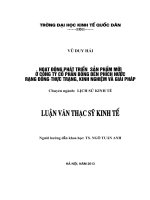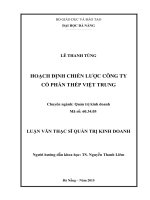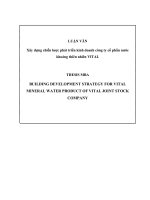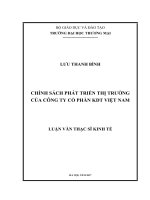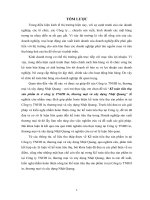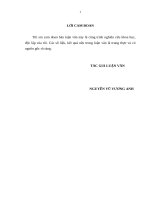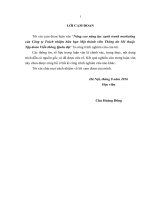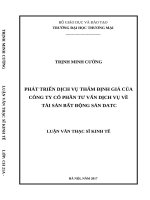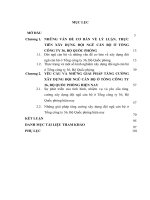(Luận văn thạc sĩ) improving employee retention at impac corporation hoàn thiện công tác giữ chân nhân viên tại công ty cổ phần IMPAC
Bạn đang xem bản rút gọn của tài liệu. Xem và tải ngay bản đầy đủ của tài liệu tại đây (1.99 MB, 116 trang )
ĐẠI HỌC QUỐC GIA HÀ NỘI
KHOA QUẢN TRỊ VÀ KINH DOANH
---------------------
NGUYỄN THÙY DƯƠNG
IMPROVING EMPLOYEE RETENTION AT
IMPAC CORPORATION
HỒN THIỆN CƠNG TÁC GIỮ CHÂN NHÂN
VIÊN TẠI CÔNG TY CỔ PHẦN IMPAC
LUẬN VĂN THẠC SĨ QUẢN TRỊ KINH DOANH
HÀ NỘI - 2019
ĐẠI HỌC QUỐC GIA HÀ NỘI
KHOA QUẢN TRỊ VÀ KINH DOANH
---------------------
NGUYỄN THÙY DƯƠNG
IMPROVING EMPLOYEE RETENTION AT
IMPAC CORPORATION
HỒN THIỆN CƠNG TÁC GIỮ CHÂN NHÂN
VIÊN TẠI CÔNG TY CỔ PHẦN IMPAC
Chuyên ngành: Quản trị kinh doanh
Mã số: 60 34 01 02
LUẬN VĂN THẠC SĨ QUẢN TRỊ KINH DOANH
NGƯỜI HƯỚNG DẪN KHOA HỌC: TS. TRẦN HUY PHƯƠNG
HÀ NỘI - 2019
DECLARATION
The author confirms that the research outcome in the thesis is the result of
author’s independent work during study and research period and it is not yet
published in other’s research and article.
The other’s research result and documentation (extraction, table, figure,
formula,
and other document) used in the thesis are cited properly and the
permission (if required) is given.
The author is responsible in front of the Thesis Assessment Committee,
Hanoi School of Business and Management, and the laws for above-mentioned
declaration.
Date…………………………..
i
ACKNOWLEDGEMENTS
I would like to express my deepest gratitude to all of the following
people for helping me complete my thesis.
Firstly, I would like to express my special thanks to my company for giving
favorable conditions for my study and my master thesis completion at Hanoi school
of business and management (HSB).
Secondly, I am extremely grateful to all of the lecturers from the Department
of Business Administration - HSB for providing me with research methods and
professional knowledge during the course, especially the active and creative
research skills.
My appreciation also goes to the teachers in the thesis review committee for
giving me valuable ideas during my thesis completion process.
My profound gratitude is also conveyed to my instructor for his helpful
assistance and guidance. This thesis could have never been completed without his
enthusiastic counsel and support.
Despite the efforts during the research period, there are still many limitations
in the thesis. I would hope to receive valuable comments from the teachers and coworkers to make this essay more complete.
Thank you very much./.
Ha Noi,
ii
2019
TABLE OF CONTENTS
DECLARATION ....................................................................................................... i
ACKNOWLEDGEMENTS ..................................................................................... ii
LIST OF TABLES .................................................................................................. vi
LIST OF CHARTS AND FIGURES .................................................................... vii
INTRODUCTION .....................................................................................................1
CHAPTER 1. THEORETICAL BASIS ON RETAINING EMPLOYEES IN
ENTERPRISES AND RESEARCH DESIGN ........................................................9
1.1. Concept and role of retaining employees in enterprises.................................9
1.1.1. Concept ..........................................................................................................9
1.1.2. Role ..............................................................................................................10
1.2. Basic factors effecting employee retention.....................................................11
1.2.1. Factors belong to the enterprise ...................................................................11
1.2.2. Factors belong to employees .......................................................................13
1.3. Theories of working motivation to retain employees ....................................15
1.3.1. Theories about needs ...................................................................................15
1.3.2. Theory of two groups of elements of F.Herzberg (1959) ............................19
1.3.3. Equity theory of J.Stacey Adams.................................................................20
1.3.4. Victor Vroom’s Expectancy theory of Motivation (1964) ..........................22
1.4. Content of retaining employees ......................................................................23
1.4.1. Determine the need of employees................................................................23
1.4.2. Retain employees with material tools ..........................................................24
1.4.3. Retain employees with spiritual tools ..........................................................28
1.5. Experience on retaining employees in SMEs .................................................34
1.5.1. Experience of L&A (Le&Associates –specializes in providing manpower
solutions for businesses) ........................................................................................34
1.5.2. Experience of United education Joint Stock Company ...............................35
1.5.3. Lessons learned for Impac Corporation .......................................................35
iii
1.6. Research design ................................................................................................36
1.6.1. Proposal of analytical framework ................................................................36
1.6.2. Designing questionaire ................................................................................38
1.6.4. Data collection methods ..............................................................................39
1.6.5. Methods of processing and analyzing data ..................................................40
CHAPTER 2: CURRENT SITUATION OF EMPLOYEE RETENTION AT
IMPAC CORPOTATION ......................................................................................42
2.1. General overview of Impac Corporation .......................................................42
2.1.1. Process of formation and development of the Company.............................42
2.1.2. Organizational structure of the Company ....................................................42
2.1.3. Characteristics of business activities and manpower of the company ........45
2.2. Analysis of employee retention status at Impac Corporation ......................47
2.2.1. Current situation of determining the needs of employees at the Company .47
2.2.2. Status of retaining employees with material tools .......................................48
2.2.3. Status of retaining employees with spiritual tools .......................................57
2.3. Analysis of factors effecting employee retention ...........................................67
2.3.1. Factors belong to the business .....................................................................67
2.3.2. Factors belong to employees .......................................................................68
2.4. Overal assessment of the status of retaining employees at Impac Corporation69
2.4.1. Achieved results ...........................................................................................69
2.4.2. Limitations and causes .................................................................................70
CHAPTER 3. PROPOSAL OF SOLUTIONS TO COMPLETE EMPLOYEE
RETENTION AT IMPAC CORPORATION ......................................................74
3.1. Business development orientation of the Company until 2025 ....................74
3.2. Perpectives of HRM of the Company .............................................................74
3.3. Proposal of solutions to employee retention at Impac Corporation............75
3.3.1. Solutions to determine the needs of employees ...........................................75
3.3.2. Solutions of employee retention with material tools ...................................76
3.3.3. Solutions of employee retention by spiritual tools ......................................83
CONCLUSION ........................................................................................................96
iv
REFERENCES ........................................................................................................98
APPENDIX ............................................................................................................100
v
LIST OF TABLES
Table 1.1. Detailed description of the factors affecting staff retention at Impac
Corporation ...............................................................................................................37
Table 2.1. Business records of the Company in the period of 2015-2017 ................45
Table 2.2. Labor situation of the Company in the period of 2015-2017 ..................46
Table 2.3. Payroll of employees at the Company in December 2017 (quoted) ........51
Table 2.4. Results of employee survey on salary of the Company ...........................52
Table 2.5. Total paid bonuses of the Company in the period of 2015 - 2017...........53
Table 2.6. Results of staff survey on bonuses of the Company ................................54
Table 2.7. Forms of welfare, allowance and subsidies applied at Impac Corporation .....56
Table 2.8. Result of staff survey on the Company’s welfare ....................................56
Table 2.9. Results of staff survey on work assignment in the Company ..................57
Table 2.10. Results of staff survey on the stability of work at the Company ...........58
Table 2.11. Comparing the number of employees of the Company in the period of
2015 - 2017 ...............................................................................................................59
Table 2.12. Survey results of staff on working environment and conditions at the
Company ...................................................................................................................61
Table 2.13. Survey results of employees on the assessment of work performance at
the Company .............................................................................................................62
Table 2.14. Training needs at the company in the period of 2015-2017 ..................63
Table 2.15. The situation of using the training and development budget at the
Company in the period of 2015 - 2017 .....................................................................65
Table 2.16. Results of staff survey on training and promotion opportunities in the
Company ...................................................................................................................66
Table 3.1. Survey form of employees’ needs at Impac Corporation ........................75
Table 3.2. Sample of work performance assessment form .......................................78
Table 3.3. Norms of the bonus level according to the coefficient of work completion ...80
Table 3.4. Sample of job description form................................................................84
Table 3.5. Questionnaires identifying training needs for employees in the Company ....91
vi
LIST OF CHARTS AND FIGURES
Figure 1.1. A. Maslow's hierarchy of Needs .............................................................16
Figure 1.2. Influence of factors .................................................................................20
Figure 1.4. Analytical frameworks............................................................................37
Figure 2.1. Company organization chart ...................................................................43
vii
INTRODUCTION
1. Rationale
Among the resources required to create the social and economic development of the
nation in general and of each enterprise in particular, Human resources are viewed as the
core resource for creating material value, creating the most competitive and decisive
position for other resources. In addition to building a business strategy, Enterprises need
to have a human development strategy commensurate with human capital as Human
resource is an important factor in turning a business strategy into reality.
Today, retaining employees is not just an administrative issue but requires
organizations to recognize the importance of coordinating policies, goals and
employee retention practices which is the work of all managers and the process of
combining systems, policies and governance measures to recruit, retain and develop
qualified staff to meet requirements in performing the overall goal of the
organization. Therefore, in order to promote human resource efficiency, staff
retention should be developed and implemented as part of the overall strategy of the
organization. However, in Vietnam, most businesses are not really aware of the
importance of this work, causing "bleeding" talent became quite common. At the
same time, it can be seen that our high-qualified human resources market is facing
serious crisis because it can not catch up with the development of the economy.
As a company operating in the field of investing and providing transfering
technology of medical equipment, science and technology, including both specific
and competitive features, Impac Corporation has identified human development as
an important strategic task to build and develop the Company into an enterprise that
is able to meet the increasing demands of customers, especially with health care
products. As a result, retaining employee is increasingly attracted by the Company's
leaders in order to build and develop strong human resource in all aspects,
sufficiently quantitatively with high levels of education and management capacity,
creativity and application of new technology.
1
However, the company still has a lot of personnel changes, especially middle
management staff and highly qualified staff. This is due to the current status of staff
retention in the company has some limitations such as:
- The actual income of employees at the company is not high;
- The laborers have not been given much conditions to raise their professional
qualifications and development;
- Reward activities are uneven;
- The assignment of labor is not reasonable, many employees have to concurrently
undertake many jobs causing overloaded.
So far, there is a lack of research to address the above shortcomings for Impac
Corporation.
Based on that practice, the author chose the topic: "Improving employee retention
at Impac Corporation" as the master thesis topic in order to better understand the
real situation of retaining employees at the Company, thereby recommend solutions
with the desire to further improve staff retention at Impac Corporation.
The subject focused on some theoretical issues and the status of staff retention at
Impac Corporation. Thereby, to see strengths, weaknesses, causes exist to propose
some solutions to improve this work in the Company; and hope to answer the
question: What should the Board of Directors of Impac Corporation do to improve
the staff retention in the company in the future?
2. Literature review
Foreign studies on staff retention are seen in many different perspectives and
names. Research related to this issue mainly refers to associating employees with
the organization as a key therapist to retain them. Some typical studies such as:
2.1.
Abroad research situation
The study by Shruti and Nirmala (2013) investigates the impact of human resource
management practices on the organizational commitment of employees in various
sectors in India. Research shows how the human resource management practices
bring the advantage of employee engagement to organizational goals in a globally
competitive marketplace. The results show the factors of promotion, satisfaction,
2
job characteristics, communication, leadership satisfaction, job satisfaction, external
exchanges, internal exchanges, external rewards and internal rewards are positively
and significantly related to cohesion among employees.
According to the study by AK Paul and RN Anantharaman (2004) on the impact of
human resource management on organizational engagement among software
professionals in India and research shows that Human resource management
activities such as friendly environment to employees, career development,
development orientation, and comprehensive training have a significant positive
relationship with engagement with the organization.
The Asma and Mehboob study (2012) examines the effects of human resources on
the organization association of workers in the service sector of Pakistan. This
research identifies the practical activities of human resources such as the sense of
organizational support, communication - training and development, compensation,
organizational
environment,
work
life
policy,
professional
development,
empowerment. The results show the positive relationship of these factors in HR
practices with engagement with employees' organizations.
Meyer et al. (2000) also provided in their analysis their findings on the causal
factors of association with the organization. These factors include: absenteeism and
awareness of leaving the organization, absenteeism, job performance, civic behavior
in the organization, tensions and conflicts between job and family; In addition, they
also show an additional factor related to health and welfare.
2.2.
Research situation within country
In the study of organizational attachment and job satisfaction, two authors, Tran Kim
Dung and Morris (2005), have adapted Mowday's scale to Vietnam's condition, and the
results show three parts of cohesion are influenced by five aspects of employee job
satisfaction: work, payment, colleagues, supervisors, and promotion. In terms of
Vietnam, the cohesion of employees with the organization has three components: Effort
(effort to fulfill responsibilities, assigned tasks); Pride (as a member of the organization)
and loyalty (the desire to remain a member of the organization).
Do Phu Tran Tinh et al. (2012) surveyed 200 laborers working in agencies and
enterprises in Ho Chi Minh City, who concluded that promotion opportunities are
3
the most influential factor in the decision to continue to work of young employees
at the company, followed by reward and welfare policies, relationships with leaders,
working condition and, finally, the extent to which they match their career goals.
This study also confirms that income does not have to be an important determinant
of the attachment of young workers to business.
Pham The Anh et al. (2013) in the article on Human Resource Management and
Employee Engagement in Enterprises has provided the basic indicators of cohesion:
loyalty, pride, effort. At the same time, the authors also analyzed three factors that
strongly influenced worker engagement: career development opportunities,
remuneration, and job descriptions.
In 2013, Dale Carnegie Vietnam has teamed up with the MSW to conduct a Team
Cohesion Study, which is being deployed in 87 countries in the Dale Carnegie
office, including Vietnam. The study was conducted with 700 employees in
Vietnam and concluded that there are three main factors affecting employee
engagement: direct relationship with manager, belief in senior leaders, pride when
working for the company. The study also assessed the degree of coherence and
correlation with the criteria of education, sex, title, income, seniority, salary, etc.
2.3.
Study space/niche
All of these studies have conducted research on many aspects of employee retention
in both theoretical and practical aspects. In general, the research addresses the
following issues:
- Identify factors that affect employee engagement and the reasons they leave the
organization;
- Analysis of the factors that satisfy with the work of the employees;
- Domestic studies have been applied to the actual situation of Vietnamese workers
in general;
Although there are many studies related to researching topics, these studies are in
the implementation process as well as their results are limited. The subjective and
objective shortcomings are that these studies only solve the problem of cohesion or
the problem of job satisfaction for workers in general.
4
In addition, human resources of enterprises operating in field of investing and
providing technology transfering of medical equipment, science and technology are the
subjects working in the private sector which is different from other sectors of economy,
having specific characteristics and complying with separate management regulations of
the industry sector. Without specific research, the general theoretical basis of employee
retention and associated with the particularity of the industry sector can not be taken
into account in an overview and practice of employee retention. It is also impossible to
recommend a viable solution for employee retention. Therefore, the topic will be the
new research direction to help improve the staff retention at Impac Corporation to
meet the practical requirements and conditions.
3. Aims of research
The goal of the research is to improve the staff retention at Impac Corporation to
meet the practical requirements and conditions.
To achieve this goal, the author identifies the following research tasks:
- Systematize the theory of retention of employees in the enterprise;
- Analyzing the real situation of staff retention at Impac Corporation in the phase of
2015 -2017; Evaluating the success and limitations of staff retention of the
Company;
- Studying the development orientation of the company, the position of employees
retention of Impac Corporation as the basis for proposing solutions.
4. Objects of research
The research focused on the work of staff retention at Impac Corporation.
5. Scope of research
- Scope of space: The topic researches on the actual situation at Impac Corporation
- Scope of time: With secondary data, the topic uses the actual data of Impac
Corporation in the period of 2015 - 2017.
With primary data, the collection process is carried out from August 2018 to
October 15, 2018
The thesis proposes solutions to retain Impac's employees by 2025
- Scope of content: The study focuses on researching policies to retain employees at
5
Impac Corporation in order to stabilize operations, increase business efficiency and
competitiveness of the Company.
6. Research Method
6.1.
Research Process
Basing on the rationale for retaining employees was presented above and the actual
situation at Impac Corporation, the thesis mainly uses quantitative methods through
investigation and survey of employees who have been working at the Company by
questionnaires, general analysis and statistics, comparing the results obtained to access
actual situation of staff retention at the Company in the period of 2015 - 2017 (details of
the Process of conducting research in Figure 1.3); The research helps to develop the
Company orientation, thereby serving as a basis for the author to propose solutions to
improve the retention of employees at the Company in the future.
Objectives of the study
Researching the basis for
retaining employees
Researching
documents
Designing
Investigation
Processing Investigation
Primary data
Secondary data
Processing and analysis data
Research result
Figure: Processing of conducting research
(Source: proposed by the author)
6
6.2.
Data collection method
- Secondary data: The study uses data collected from internal documents, reports
and information of Impac Corporation from 2015 to 2017, data sources collected
from outside like the central ministries, publications have been published
(textbooks, articles, magazines, internet, thesises etc).
- Primary data: To assess the satisfaction of employees on retention policies at
Impac Corporation, the author conducted a survey to survey employees who have
been working at the company by questionnaire according to the 5 corresponding
level assessment scale: 1 - Absolutely disagree to 5 - Absolutely agree.
The survey method is the method of using research techniques to collect data and
can be expressed by statistics and tables.
The survey results will be statistically and synthesized, and processed by Excel
software to form an overall view of the situation of retaining employees at Impac
Corporation, helping to orient feasible solutions.
6.3.
Data processing method
Analytical method is to study different documents, reasoning materials about
retaining employees and then analyzing them into each part, each face by time to
understand them fully and comprehensively.
Synthesis method is a method of linking each item, each part of information from
the collected theory to create a new, complete theory system of retaining
employees. In addition, document synthesis helps the author have a comprehensive
and more general view of the existing documents on retaining employees in the
enterprise.
Statistical method is a system of methods such as collecting, synthesizing,
presenting data, calculating characteristics of retention of employees at Impac
Corporation
to serve as the process of analysis, prediction, decision making and use in statistics
of collected data in order to synthesize generalized data for analysis, evaluation and
conclusions.
7
Comparison method is a method to consider the analysis criteria based on the
comparison of data with an original indicator and this method is used to obtain
specific indicators of value, volume and growth speed of research issues during
analysis. At the same time, comparing the survey results to synthesize research
results in a general way.
In chapter 2 of the thesis, the author will list and summarize the collected figures,
and conduct processing with Excel software and present in the form of tables and
forms, thereby forming an overview of current status of retaining employees at
Impac Corporation.
7. Thesis structure
In addition to the instruction, conclusion, references, appendixes, the contents
of the thesis are divided into three chapters as follows:
Chapter 1. Theoretical basis on retaining employees in enterprises and research
design.
Chapter 2. Current situation of employee retention at Impac Corporation.
Chapter 3. Proposal of solutions to complete employee retention at Impac
Corporation
8
CHAPTER 1. THEORETICAL BASIS ON RETAINING EMPLOYEES IN
ENTERPRISES AND RESEARCH DESIGN
1.1. Concept and role of retaining employees in enterprises
1.1.1. Concept
Employee retention is an enterprise activity that creates an environment for longterm staff participation. According to Chaminade (2007), this close relationship
should be durable and link employees to the organization by common values and by
the way the organization meets the needs of its employees.
The main purpose of retaining employees is to prevent the loss of qualified
employees of enterprises, which could have an adverse effect on productivity and
service delivery. In addition, retaining employees allows senior managers and
managers to effectively attract and maintain employees with important skills and
high productivity. This is achieved by providing managers with information on
employee retention strategies that will ensure that the goals and objectives of
businesses are implemented.
Creating a retention strategy means putting the organization's needs and
expectations upwards to ensure the professional satisfaction of employees and
create a reliable relationship. In this stable relationship, employees stay with
personal choice based on freedom and consideration of decisions. Retaining
employees contributes an important part to the overall success of the organization.
Highly talented and effective employees need to be encouraged to stay in the
organization by designing maintenance policies that will provide employees with
opportunities to prove their skills and ensure that they fit the job.
Also discussing retention policies, Nyoka's (2006) perspective includes strategies
that will allow workers to balance the needs of their work life with their family life
by set up family-friendly policies and allow flexible work arrangements to match
the necessary personal issues.
With such an effective on-site maintenance policy, so managers can keep
employees at a manageable level. This is mandatory for organizations through the
9
labor process, to attract quality staff for the organization. However, it is important
for managers to devise policies to retain talented employees in their organizations to
prevent employers from benefiting from the investment made in it. Retaining
employees is one of the most important issues for organizational managers as a
result of the shortage of skilled manpower, economic growth and the rate of
employees retiring.
Phillips and Connell (2002) stated that retaining employees relates to worker
sensitivity and demonstrates different strategies for meeting those needs. According
to Czakan (2005) strategies include career promotion and development,
compensation entitlements, opportunities for training and management support. In
addition to the strategies mentioned above, labor managers should use a flexible
approach to encourage maintenance and this method should consider some valueadded components. Brown (2006) argues that these strategies include training,
opportunities for skill and career development, as well as flexibility around the
frequency and size of rewards and incentives. The whole process of retaining
employees is to ensure that employees stay in the organization, especially
employees with valuable or necessary skills or experience in an important area.
Employees who leave work are costly and are a great concern for employers and
should be avoided. The high rate of retired employees represents a significant
burden on human resource managers and direct managers, who constantly have to
recruit and train new employees.
1.1.2. Role
Retaining employees plays an important role and the benefits of retaining
experienced, reliable employees are invaluable, helping businesses operate stably,
reducing the cost of changing employees.
- In terms of revenue, loyal employees tend to work better than what customers
expect and always have a high working spirit at their best. These two characteristics
are very important in retaining loyal customer for the business and bringing in high
revenue.
10
- In terms of cost, loyal employees will stay long-term, rejecting offers from
competitors, not actively seeking new jobs and always introducing their businesses
are good working place. This helps businesses avoid significant expenses for
employee replacement (Nguyen Thi Huong, 2015, page 8).
1.2. Basic factors effecting employee retention
1.2.1. Factors belong to the enterprise
- Objectives of the organization
The goal of the organization is to guide all activities of the organization and the
working process of the employees. The objective of the organization must ensure
harmony between organizational benefits and the interests of employees. The goal
is to decide on each organization's human resource development strategy to the
policy of attracting, using and treating employees.
- Leadership method: Is the overall way of possible and intentional impact of
leaders on employees along with other resources to achieve the proposed
management goals. The important role of leadership methods is to arouse
motivations, stimulate the dynamics, creativity of employees and potential in the
organization as well as other potential and opportunities from the outside (Doan Thi
Thu Ha and Nguyen Thi Ngoc Huyen, 2011, pages 277-278).
- Organizational motivational tools (Nguyen Van Diem and Nguyen Ngoc Quan,
2007, page 128)
In order to create motivation, managers use many different tools to impact on
management objects such as material tools or material dynamics (income policy:
salary, bonus, allowance, welfare, profit etc.); spiritual tools or motivation (about
work, work environment, promotion opportunities etc.).
+ Income policies of the organization
Organizations use employees through the system of income policies, including
policies to ensure employees' benefits: salary, bonus, social insurance (social
insurance), allowances etc. In terms of organizational management of human
resources, policies on salary, social insurance, allowances are a group of factors to
attract and maintain employees (necessary conditions). As for the bonus policy, it is
11
really motivating for employees' efforts (sufficient conditions). However, for some
individuals, a reasonable salary policy and a full social insurance policy are also
motivators for their efforts to complete the assigned work.
The income policy tool should take into account the payment by position, capacity
and working results that contribute to competition and employee incentives,
especially for highly educated employees.
+ Working environment and organization's culture
Attached to the job is the working environment. The working environment in addition
to the labor conditions also includes: the atmosphere in the organization, the
relationship between colleagues with colleagues, superiors and subordinates etc. Proper
working conditions must first create comfort and help focus thinking, besides the
conditions of labor materials must bring convenience for employees at work.
Organizational culture is a system of common values and norms recognized by all
employees in the organization, and their behavior towards the inside and outside of
the organization. The culture of the organization will influence the behavior,
internal behavior and external behavior of employees in the organization. Strong
culture appeals to talents and promotes creative passion. Therefore, in motivating
work, it is necessary to build and maintain a strong culture.
+ Ability to promote at work
Promoting in the job is the development in the career ladder, expressing the need to
be recognized and affirmed in the organization. In fact, a good employee often has a
progressive spirit. They are always eager to seek opportunities to advance their
career development. Therefore, creating favorable conditions for training and
working to promote is a factor to encourage and motivate employees.
+ Work of the organization
Work is all tasks performed by an employee or all the same tasks performed by
some employees (Nguyen Van Diem and Nguyen Ngoc Quan, 2007, page 44). The
requirements of the work include: knowledge, skills, education, experience ... The
creation of work is the result of assignment of labor within the organization.
12
In an organization there will be many works with different tasks and levels of
complexity. The more complex the work is, the more skilled and skilled employees
are required. This affects the role and position of employees in the organization, as
well as their salaries, satisfaction and attitudes in labor. Moreover, the stability of
the work also has an impact on the experience and working capacity of the labor
force. Therefore, arranging "right people, right works" is one of the principles to
retain employees as well as bring success to the organization.
- Other human resource management activities of the organization
Other human resource management activities of the organization such as: human
resource planning; work analysis and design; recruiting, arranging human resources;
Training and developing human resources; evaluating the performance of the work
... Thereby, considering the capacity, achievements and prospects of each employee
thus making relevant personnel decisions. The results of these activities affect the
emotional sentiment of each person, so they need to be done correctly. Moreover,
these activities play a central role in establishing organizations and helping
organizations survive and grow. Human resource is one of the indispensable
resources of the organization, so human resource management is an important area
that is crucial to the success of the organization. Appropriate human resource
management activities will increase the motivation of employees in the organization
and vice versa.
1.2.2. Factors belong to employees
- Personal’s goal (Nguyen Van Diem and Nguyen Ngoc Quan, 2007, page 128)
The goal is the desire of employees to work, which motivates employees to work.
The higher the goal, the more personal effort is needed to achieve, so each person's
motivation is also higher.
However, each employee has a specific goal, if these objectives are consistent with
the overall goal of the organization, the organization will develop and vice versa.
Therefore, the administrator needs to capture the personal goals of the employees
and direct them to the overall goals of the organization.
13
- Needs and motives of employees (Nguyen Van Diem and Nguyen Ngoc Quan,
2007, page 128)
Behavior originating from needs so people have two ways of satisfaction and
dissatisfaction with the organization. Dissatisfaction is caused by: the organization's
policies; inadequate work supervision; working conditions do not meet employee
expectations; salaries and remuneration containing unfair factors; having problems
with colleagues. Satisfaction is due to: achieving expected results; acknowledgment
of organizations and colleagues; responsibility; promotion. Encourage employees
need to satisfy both maintenance and promotion factors.
- Actual capacity of employees: This is a factor showing the ability to solve work,
knowledge, professional qualifications on the work. It impacts both sides to
motivate employees, it will strengthen if individuals are qualified to deal with the
work, otherwise it will discourage individuals in solving work.
- Seniority, working experience: They are factors that are interested in labor
remuneration and labor arrangement and are expressed in the period of time that
employees have been attached to the job. The higher the seniority and the labor
experience, the higher salary the labor will require and vice versa.
- Values and attitudes
Value is what belongs to the concept, beliefs and practices associated with human
emotions. Values include issues such as honesty, loyalty, freedom and
responsibility. Values are important to employees because they affect people's
material desire and professional ethics.
Attitudes are positive, negative assessments, feelings and tendencies of people for a
concept or object. This factor is influenced by many social conceptions and the
impact of those around. The attitude of employees will directly affect the outcome
of the job.
- Demographic characteristics: Includes gender, age, race and religion. These
factors also greatly affect the labor motivation of employees. Administrators also
need to be aware of the gender, age, race and religion differences of employees to
take appropriate measures to motivate them.
14
1.3. Theories of working motivation to retain employees
1.3.1. Theories about needs
1.3.1.1. Abraham Maslow’s hierarchical doctrine of demand (1943)
Content of theory
Abraham Maslow said that human behavior stems from need. These needs have
different levels and are prioritized from low to high. When low-level needs are
satisfied, a demand at a higher level becomes a driving force. After a need is met,
another need will appear. As a result, people always have unmet needs and these
needs motivate people to perform certain tasks to satisfy them.
- Basic needs (Physiological needs): are the basic needs to be able to maintain
human life such as food, clothing, drinking water, housing ... A. Maslow believes
that, when this need has not been satisfied to the extent necessary to sustain life,
other needs will not motivate people. In an organization, employees first need to be
properly paid to be able to support themselves and their dependents, ensuring their
minimum living standards so they can survive.
- Need for safety: Needs to avoid the danger of body and the threat of losing jobs or
losing assets. Employees in organizations want to work in safe places, leaders care
about their health and safety. Moreover, they also want the stability of their work to
ensure a long life, they do not want to risk losing their jobs all the time. In an
organization, the expression of assurance of safety needs can be working conditions,
labor contracts, policies on social insurance, unemployment insurance, health
policies, retirement regimes etc.
- Social need (need for association and acceptance): is a need for friendship, love,
family affection and integration need in social life. People with high social needs
prefer to work with the participation of many people. In the organization, this need
is expressed through the expectations of the employees about good relationships
with colleagues as well as superiors, being able to participate in collective activities,
working in teams. In order to help employees meet this need, administrators need to
encourage them to cooperate in a friendly manner, actively participate in the group's
collective activities such as sports, arts, picnics etc.
15
- Self-esteem need: according to A. Maslow, when people begin to satisfy the need
to be accepted as members of society, they tend to be self-respected and want to be
respected by others. People with high respect needs often work hard and try to
improve the skills needed to succeed. It is expressed through the expectations of
employees about the reward / special bonus for their dedication, the promotion in
the public, being admired by colleagues, and having superior trust. This need allows
them to build pride for their employees, motivate them to complete their work with
high quality, giving them opportunities to show their abilities and bravery.
Self –
actualization need
Esteem need
Belongingness and love need
Safety needs
Physiological Needs
Figure 1.1. A. Maslow's hierarchy of Needs
(Souce: Bùi Anh Tuấn và Phạm Thúy Hương, 2013, trang 94 - 95)
- Need for self-actualization: A. Maslow sees this as the highest need in his
decentralization. The ultimate goal of people is to improve themselves, or to
develop
comprehensively all potential possibilities in the field that they are
talented. The highest level is the need to express people who can master themselves
and be able to influence others, who are creative, have a high sense of selfawareness and are able to solve problems. This is the most difficult need to be
satisfied. Employees who have met the need to be respected will feel the desire to
express their creativity in their work and development as well as face more difficult
challenges. Employees always want to become better and better. Administrators
16
